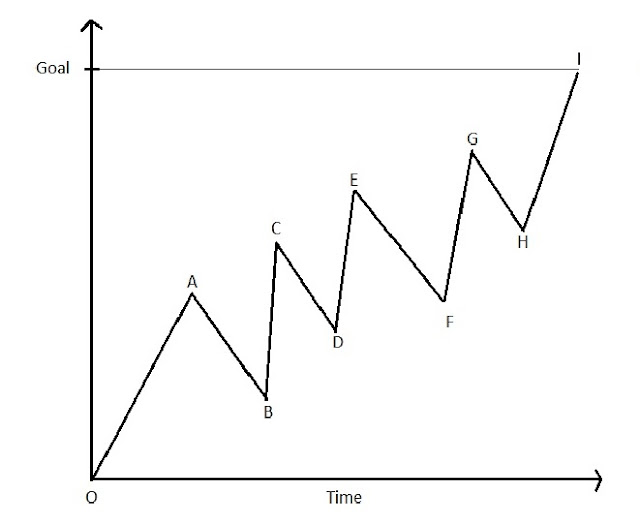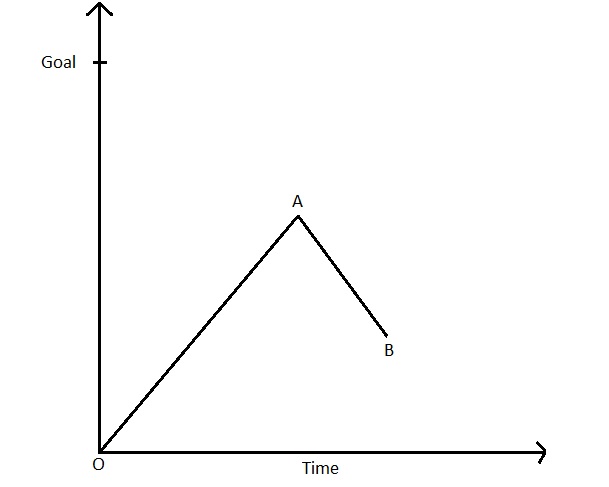Do you find yourself unable to stick to your goals?
Do you quit on your goal as soon as you encounter the first hurdle?
Have you made resolutions countless times only to break them later?
Have you made resolutions countless times only to break them later?
If your answer is in the affirmative to any of the above questions, you’re not alone. Most people are like this because it’s the default way our brains are wired.
With the help of this post, I hope to create a shift in your mindset that will enable you to persist until you accomplish your important goals.
We’re wired for short-term rewards
For the most part of our evolutionary history, our ancestors hunted and gathered food. These were activities that provided instant gratification. The ability to think long-term and plan ahead is fairly recent in our evolutionary history.
This is why it’s easy to indulge in an activity that promises a reward now and difficult to delay gratification. It takes some mental effort to delay gratification and think long-term.
When you’re doing a task, your brain’s default wiring makes it ask, “Is this activity giving me what I want?” This is because you’re inclined to think that rewards are to be attained as soon as possible, that either your activity is taking you towards your goal or away from it.
When you reach A starting from O, you see yourself making progress and are highly motivated as a result.
Soon, something goes terribly wrong and you hit a low point B. At B, the goal seems too far away and you’re motivated to quit because you don’t see your efforts yielding any fruits.
Soon, something goes terribly wrong and you hit a low point B. At B, the goal seems too far away and you’re motivated to quit because you don’t see your efforts yielding any fruits.
Most people quit at this point because, remember, our mind is constantly asking us, “Is this activity giving me what I want?”
If the answer to that question is “No” there’s no point in motivating you to continue pursuing your goal and you’re in a state of demotivation. So you quit because that’s the sane thing to do in such a situation.
A task that eats away your time, energy and resources without providing you with any benefit is perceived as costly by your mind.
You could devote your time, energy and resources to something else that’s probably more promising- such as tasks that provide you with instant gratification. (see why we do what we do and not what we don’t do)
You could devote your time, energy and resources to something else that’s probably more promising- such as tasks that provide you with instant gratification. (see why we do what we do and not what we don’t do)
It’s not over yet
What if you hijack the way your mind works to prevent yourself from quitting when things don’t go your way?
The figure A shown above tells us that when we do things that take us closer to our goals we’re motivated to continue and when we do things that take us away from our goal, we’re de-motivated and likely to quit.
What if I told you that figure A is not the whole story?
Yes, figure A is actually a part of a larger figure B shown below…
 |
| figure B |
The obstacle you faced at B that motivated you to quit was just one of the many obstacles that you were going to face on the journey towards reaching your goal.
Most people quit at B, others do so at D, yet others at F, and some at H. When people are at A, C, E, and G they’re highly motivated because their mind is telling them, “Yes, what I’m doing now has taken me closer to my goal.”
The key message that figure B is sending you is that no matter how many low points and high points you hit on the road to accomplishing your goal, the general trend of the graph is akin to a straight line going upward.
 |
| figure C (representing the general trend of figure B) |
When you remember this you can trick your mind into thinking that what you’re currently doing is, after, all taking you closer toward your goal over time. You hack your short-term brain wiring to apply it to long-term thinking.
The low point that you may be currently experiencing is but a temporary inconvenience, an insignificant dip in the general upward trend of your efforts.
Whether you’re trying to lose weight, build muscle, start a business, or write a book, and have hit a low point, remind yourself that if you persist you’ll eventually get there.


